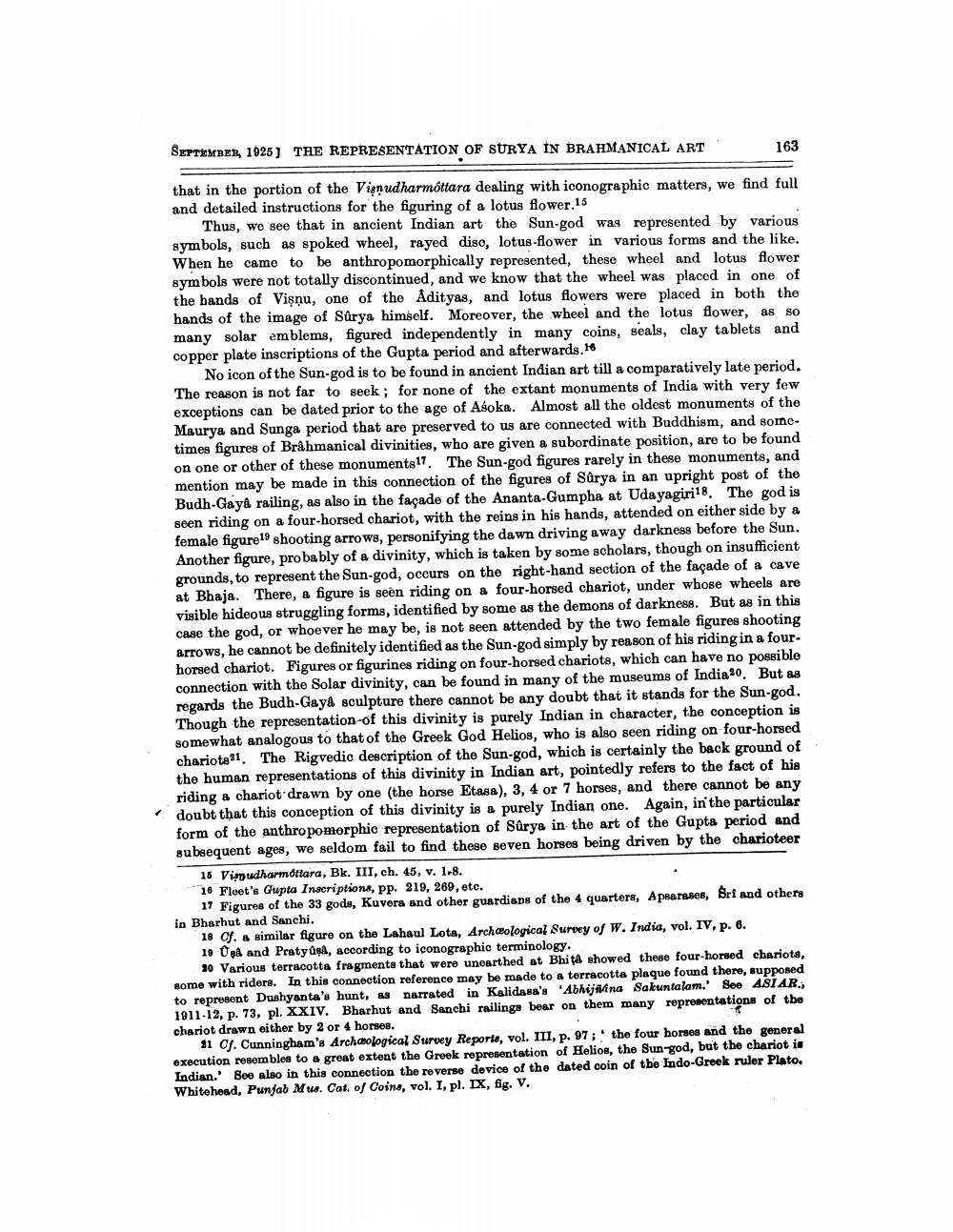________________
163
SEPTEMBER, 1925] THE REPRESENTATION OF SURYA IN BRAHMANICAL ART
that in the portion of the Vienudharmôttara dealing with iconographic matters, we find full and detailed instructions for the figuring of a lotus flower.15
Thus, we see that in ancient Indian art the Sun-god was represented by various symbols, such as spoked wheel, rayed disc, lotus-flower in various forms and the like. When he came to be anthropomorphically represented, these wheel and lotus flower symbols were not totally discontinued, and we know that the wheel was placed in one of the hands of Visņu, one of the Adityas, and lotus flowers were placed in both the hands of the image of Sûrya himself. Moreover, the wheel and the lotus flower, as so many solar emblems, figured independently in many coins, seals, clay tablets and copper plate inscriptions of the Gupta period and afterwards. 16
No icon of the Sun-god is to be found in ancient Indian art till a comparatively late period. The reason is not far to seek; for none of the extant monuments of India with very few exceptions can be dated prior to the age of Asoka. Almost all the oldest monuments of the Maurya and Sunga period that are preserved to us are connected with Buddhism, and sometimes figures of Brâhmanical divinities, who are given a subordinate position, are to be found on one or other of these monuments17. The Sun-god figures rarely in these monuments, and mention may be made in this connection of the figures of Sûrya in an upright post of the Budh-Gaya railing, as also in the façade of the Ananta-Gumpha at Udayagiri18. The god is seen riding on a four-horsed chariot, with the reins in his hands, attended on either side by a female figure19 shooting arrows, personifying the dawn driving away darkness before the Sun. Another figure, probably of a divinity, which is taken by some scholars, though on insufficient grounds, to represent the Sun-god, occurs on the right-hand section of the façade of a cave at Bhaja. There, a figure is seen riding on a four-horsed chariot, under whose wheels are visible hideous struggling forms, identified by some as the demons of darkness. But as in this case the god, or whoever he may be, is not seen attended by the two female figures shooting arrows, he cannot be definitely identified as the Sun-god simply by reason of his riding in a fourhorsed chariot. Figures or figurines riding on four-horsed chariots, which can have no possible connection with the Solar divinity, can be found in many of the museums of India 20. But as regards the Budh-Gaya sculpture there cannot be any doubt that it stands for the Sun-god. Though the representation of this divinity is purely Indian in character, the conception is somewhat analogous to that of the Greek God Helios, who is also seen riding on four-horsed chariots 21. The Rigvedic description of the Sun-god, which is certainly the back ground of the human representations of this divinity in Indian art, pointedly refers to the fact of his riding a chariot drawn by one (the horse Etasa), 3, 4 or 7 horses, and there cannot be any doubt that this conception of this divinity is a purely Indian one. Again, in the particular form of the anthropomorphic representation of Surya in the art of the Gupta period and subsequent ages, we seldom fail to find these seven horses being driven by the charioteer
15 Viudharmottara, Bk. III, ch. 45, v. 1.8.
16 Fleet's Gupta Inscriptions, pp. 219, 269, etc.
17 Figures of the 33 gods, Kuvera and other guardians of the 4 quarters, Apsarases, Bri and others
in Bharhut and Sanchi.
18 Cf. a similar figure on the Lahaul Lota, Archeological Survey of W. India, vol. IV, p. 6.
19 Usa and Pratyusa, according to iconographic terminology.
20 Various terracotta fragments that were unearthed at Bhita showed these four-horsed chariots, some with riders. In this connection reference may be made to a terracotta plaque found there, supposed narrated in Kalidasa's 'Abhijna Sakuntalam.' See ASIAR, to represent Dushyanta's hunt, as 1911-12, p. 73, pl. XXIV. Bharhut and Sanchi railings bear on them many representations of the chariot drawn either by 2 or 4 horses.
31 Cf. Cunningham's Archeological Survey Reports, vol. III, p. 97; the four horses and the general execution resembles to a great extent the Greek representation of Helios, the Sun-god, but the chariot is Indian. See also in this connection the reverse device of the dated coin of the Indo-Greek ruler Plato. Whitehead, Punjab Mus. Cat. of Coins, vol. I, pl. IX, fig. V.




